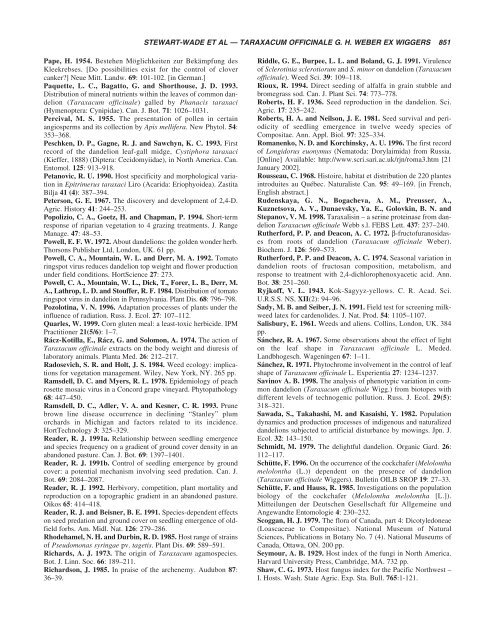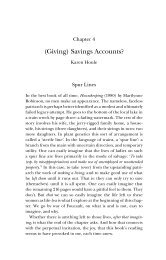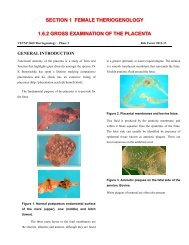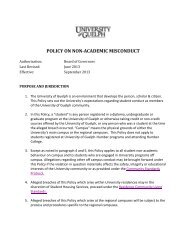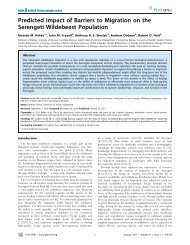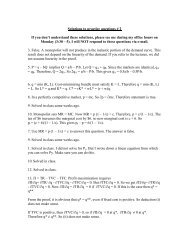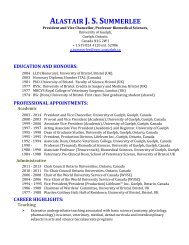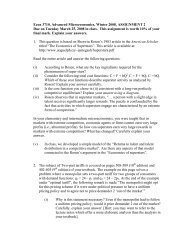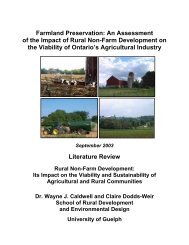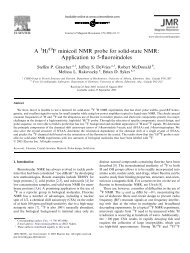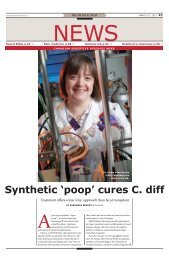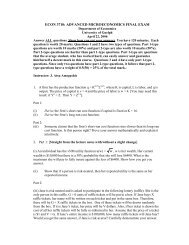The biology of Canadian weeds. 117. Taraxacum officinale G. H. ...
The biology of Canadian weeds. 117. Taraxacum officinale G. H. ...
The biology of Canadian weeds. 117. Taraxacum officinale G. H. ...
You also want an ePaper? Increase the reach of your titles
YUMPU automatically turns print PDFs into web optimized ePapers that Google loves.
Pape, H. 1954. Bestehen Möglichkeiten zur Bekämpfung des<br />
Kleekrebses. [Do possibilities exist for the control <strong>of</strong> clover<br />
canker?] Neue Mitt. Landw. 69: 101-102. [in German.]<br />
Paquette, L. C., Bagatto, G. and Shorthouse, J. D. 1993.<br />
Distribution <strong>of</strong> mineral nutrients within the leaves <strong>of</strong> common dandelion<br />
(<strong>Taraxacum</strong> <strong>of</strong>ficinale) galled by Phanacis taraxaci<br />
(Hymenoptera: Cynipidae). Can. J. Bot. 71: 1026–1031.<br />
Percival, M. S. 1955. <strong>The</strong> presentation <strong>of</strong> pollen in certain<br />
angiosperms and its collection by Apis mellifera. New Phytol. 54:<br />
353–368.<br />
Peschken, D. P., Gagne, R. J. and Sawchyn, K. C. 1993. First<br />
record <strong>of</strong> the dandelion leaf-gall midge, Cystiphora taraxaci<br />
(Kieffer, 1888) (Diptera: Cecidomyiidae), in North America. Can.<br />
Entomol. 125: 913–918.<br />
Petanovic, R. U. 1990. Host specificity and morphological variation<br />
in Epitrimerus taraxaci Liro (Acarida: Eriophyoidea). Zastita<br />
Bilja 41 (4): 387–394.<br />
Peterson, G. E. 1967. <strong>The</strong> discovery and development <strong>of</strong> 2,4-D.<br />
Agric. History 41: 244–253.<br />
Popolizio, C. A., Goetz, H. and Chapman, P. 1994. Short-term<br />
response <strong>of</strong> riparian vegetation to 4 grazing treatments. J. Range<br />
Manage. 47: 48–53.<br />
Powell, E. F. W. 1972. About dandelions: the golden wonder herb.<br />
Thorsons Publisher Ltd, London, UK. 61 pp.<br />
Powell, C. A., Mountain, W. L. and Derr, M. A. 1992. Tomato<br />
ringspot virus reduces dandelion top weight and flower production<br />
under field conditions. HortScience 27: 273.<br />
Powell, C. A., Mountain, W. L., Dick, T., Forer, L. B., Derr, M.<br />
A., Lathrop, L. D. and Stouffer, R. F. 1984. Distribution <strong>of</strong> tomato<br />
ringspot virus in dandelion in Pennsylvania. Plant Dis. 68: 796–798.<br />
Pozolotina, V. N. 1996. Adaptation processes <strong>of</strong> plants under the<br />
influence <strong>of</strong> radiation. Russ. J. Ecol. 27: 107–112.<br />
Quarles, W. 1999. Corn gluten meal: a least-toxic herbicide. IPM<br />
Practitioner 21(5/6): 1–7.<br />
Rácz-Kotilla, E., Rácz, G. and Solomon, A. 1974. <strong>The</strong> action <strong>of</strong><br />
<strong>Taraxacum</strong> <strong>of</strong>ficinale extracts on the body weight and diuresis <strong>of</strong><br />
laboratory animals. Planta Med. 26: 212–217.<br />
Radosevich, S. R. and Holt, J. S. 1984. Weed ecology: implications<br />
for vegetation management. Wiley, New York, NY. 265 pp.<br />
Ramsdell, D. C. and Myers, R. L. 1978. Epidemiology <strong>of</strong> peach<br />
rosette mosaic virus in a Concord grape vineyard. Phytopathology<br />
68: 447–450.<br />
Ramsdell, D. C., Adler, V. A. and Kesner, C. R. 1993. Prune<br />
brown line disease occurrence in declining “Stanley” plum<br />
orchards in Michigan and factors related to its incidence.<br />
HortTechnology 3: 325–329.<br />
Reader, R. J. 1991a. Relationship between seedling emergence<br />
and species frequency on a gradient <strong>of</strong> ground cover density in an<br />
abandoned pasture. Can. J. Bot. 69: 1397–1401.<br />
Reader, R. J. 1991b. Control <strong>of</strong> seedling emergence by ground<br />
cover: a potential mechanism involving seed predation. Can. J.<br />
Bot. 69: 2084–2087.<br />
Reader, R. J. 1992. Herbivory, competition, plant mortality and<br />
reproduction on a topographic gradient in an abandoned pasture.<br />
Oikos 65: 414–418.<br />
Reader, R. J. and Beisner, B. E. 1991. Species-dependent effects<br />
on seed predation and ground cover on seedling emergence <strong>of</strong> oldfield<br />
forbs. Am. Midl. Nat. 126: 279–286.<br />
Rhodehamel, N. H. and Durbin, R. D. 1985. Host range <strong>of</strong> strains<br />
<strong>of</strong> Pseudomonas syringae pv. tagetis. Plant Dis. 69: 589–591.<br />
Richards, A. J. 1973. <strong>The</strong> origin <strong>of</strong> <strong>Taraxacum</strong> agamospecies.<br />
Bot. J. Linn. Soc. 66: 189–211.<br />
Richardson, J. 1985. In praise <strong>of</strong> the archenemy. Audubon 87:<br />
36–39.<br />
STEWART-WADE ET AL — TARAXACUM OFFICINALE G. H. WEBER EX WIGGERS 851<br />
Riddle, G. E., Burpee, L. L. and Boland, G. J. 1991. Virulence<br />
<strong>of</strong> Sclerotinia sclerotiorum and S. minor on dandelion (<strong>Taraxacum</strong><br />
<strong>of</strong>ficinale). Weed Sci. 39: 109–118.<br />
Rioux, R. 1994. Direct seeding <strong>of</strong> alfalfa in grain stubble and<br />
bromegrass sod. Can. J. Plant Sci. 74: 773–778.<br />
Roberts, H. F. 1936. Seed reproduction in the dandelion. Sci.<br />
Agric. 17: 235–242.<br />
Roberts, H. A. and Neilson, J. E. 1981. Seed survival and periodicity<br />
<strong>of</strong> seedling emergence in twelve weedy species <strong>of</strong><br />
Compositae. Ann. Appl. Biol. 97: 325–334.<br />
Romanenko, N. D. and Korchinsky, A. U. 1996. <strong>The</strong> first record<br />
<strong>of</strong> Longidorus euonymus (Nematoda: Dorylaimida) from Russia.<br />
[Online] Available: http://www.scri.sari.ac.uk/rjn/roma3.htm [21<br />
January 2002].<br />
Rousseau, C. 1968. Histoire, habitat et distribution de 220 plantes<br />
introduites au Québec. Naturaliste Can. 95: 49–169. [in French,<br />
English abstract.]<br />
Rudenskaya, G. N., Bogacheva, A. M., Preusser, A.,<br />
Kuznetsova, A. V., Dunaevsky, Ya. E., Golovkin, B. N. and<br />
Stepanov, V. M. 1998. Taraxalisin – a serine proteinase from dandelion<br />
<strong>Taraxacum</strong> <strong>of</strong>ficinale Webb s.l. FEBS Lett. 437: 237–240.<br />
Rutherford, P. P. and Deacon, A. C. 1972. β-fruct<strong>of</strong>uranosidases<br />
from roots <strong>of</strong> dandelion (<strong>Taraxacum</strong> <strong>of</strong>ficinale Weber).<br />
Biochem. J. 126: 569–573.<br />
Rutherford, P. P. and Deacon, A. C. 1974. Seasonal variation in<br />
dandelion roots <strong>of</strong> fructosan composition, metabolism, and<br />
response to treatment with 2,4-dichlorophenoxyacetic acid. Ann.<br />
Bot. 38: 251–260.<br />
Ryjk<strong>of</strong>f, V. L. 1943. Kok-Sagyyz-yellows. C. R. Acad. Sci.<br />
U.R.S.S. NS, XII(2): 94–96.<br />
Sady, M. B. and Seiber, J. N. 1991. Field test for screening milkweed<br />
latex for cardenolides. J. Nat. Prod. 54: 1105–1107.<br />
Salisbury, E. 1961. Weeds and aliens. Collins, London, UK. 384<br />
pp.<br />
Sánchez, R. A. 1967. Some observations about the effect <strong>of</strong> light<br />
on the leaf shape in <strong>Taraxacum</strong> <strong>of</strong>ficinale L. Meded.<br />
Landbhogesch. Wageningen 67: 1–11.<br />
Sánchez, R. 1971. Phytochrome involvement in the control <strong>of</strong> leaf<br />
shape <strong>of</strong> <strong>Taraxacum</strong> <strong>of</strong>ficinale L. Experientia 27: 1234–1237.<br />
Savinov A. B. 1998. <strong>The</strong> analysis <strong>of</strong> phenotypic variation in common<br />
dandelion (<strong>Taraxacum</strong> <strong>of</strong>ficinale Wigg.) from biotopes with<br />
different levels <strong>of</strong> technogenic pollution. Russ. J. Ecol. 29(5):<br />
318–321.<br />
Sawada, S., Takahashi, M. and Kasaishi, Y. 1982. Population<br />
dynamics and production processes <strong>of</strong> indigenous and naturalized<br />
dandelions subjected to artificial disturbance by mowings. Jpn. J.<br />
Ecol. 32: 143–150.<br />
Schmidt, M. 1979. <strong>The</strong> delightful dandelion. Organic Gard. 26:<br />
112–<strong>117.</strong><br />
Schütte, F. 1996. On the occurrence <strong>of</strong> the cockchafer (Melolontha<br />
melolontha (L.)) dependent on the presence <strong>of</strong> dandelion<br />
(<strong>Taraxacum</strong> <strong>of</strong>ficinale Wiggers). Bulletin OILB SROP 19: 27–33.<br />
Schütte, F. and Hauss, R. 1985. Investigations on the population<br />
<strong>biology</strong> <strong>of</strong> the cockchafer (Melolontha melolontha [L.]).<br />
Mitteilungen der Deutschen Gesellschaft für Allgemeine und<br />
Angewandte Entomologie 4: 230–232.<br />
Scoggan, H. J. 1979. <strong>The</strong> flora <strong>of</strong> Canada, part 4: Dicotyledoneae<br />
(Loascaceae to Compositae). National Museum <strong>of</strong> Natural<br />
Sciences, Publications in Botany No. 7 (4). National Museums <strong>of</strong><br />
Canada, Ottawa, ON. 200 pp.<br />
Seymour, A. B. 1929. Host index <strong>of</strong> the fungi in North America.<br />
Harvard University Press, Cambridge, MA. 732 pp.<br />
Shaw, C. G. 1973. Host fungus index for the Pacific Northwest –<br />
I. Hosts. Wash. State Agric. Exp. Sta. Bull. 765:1-121.


